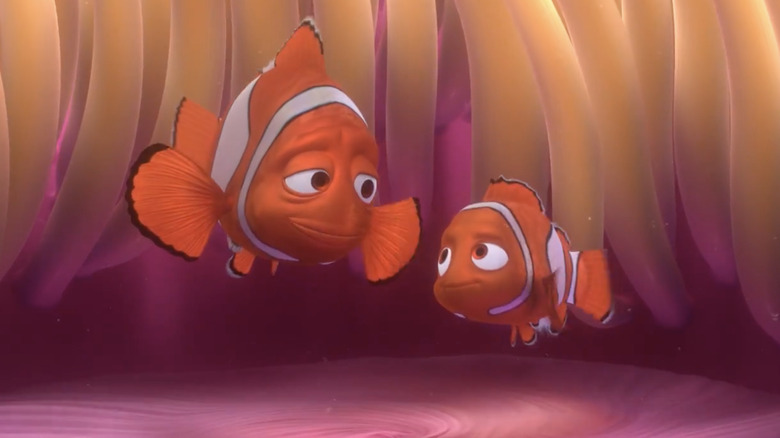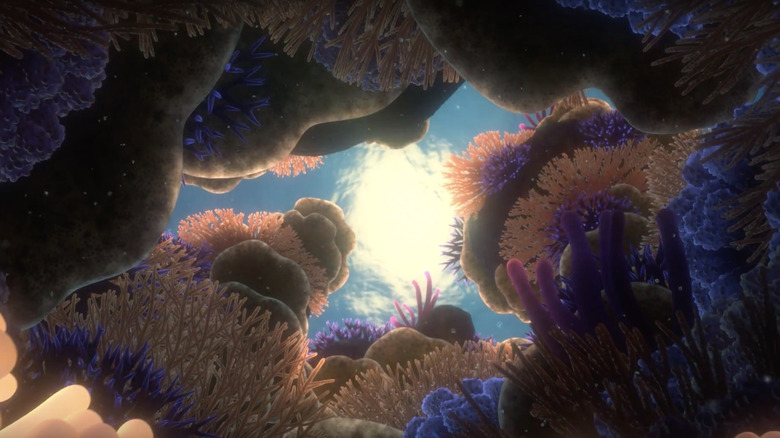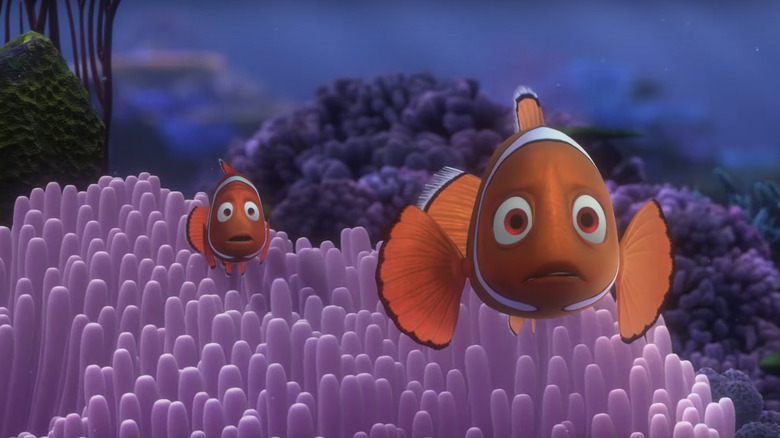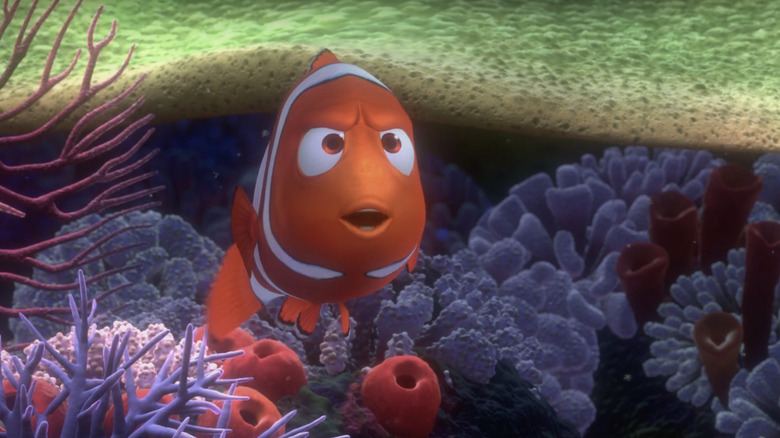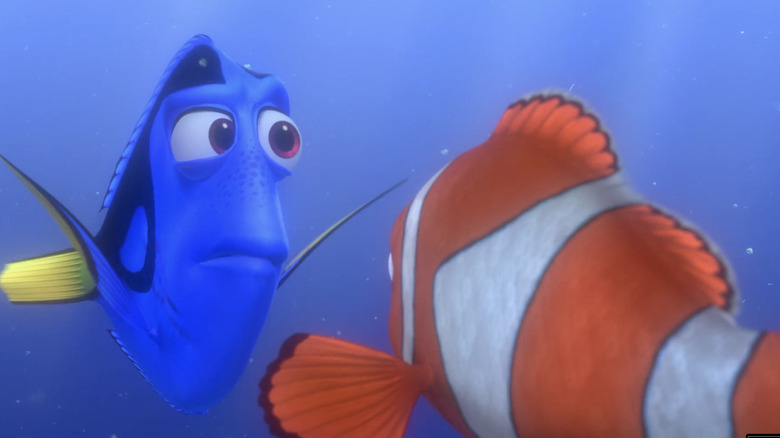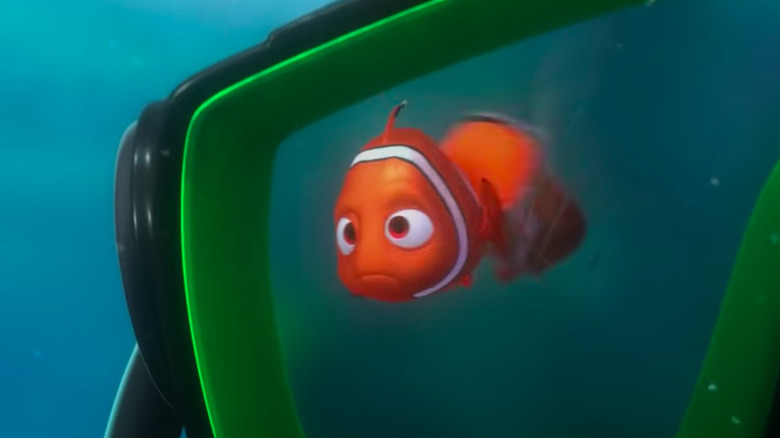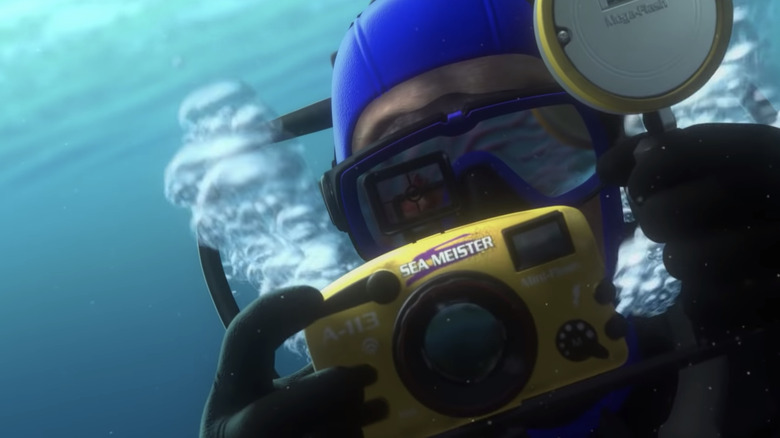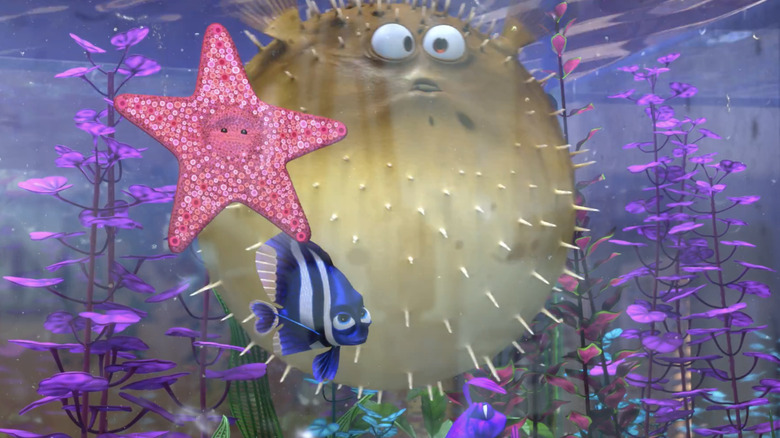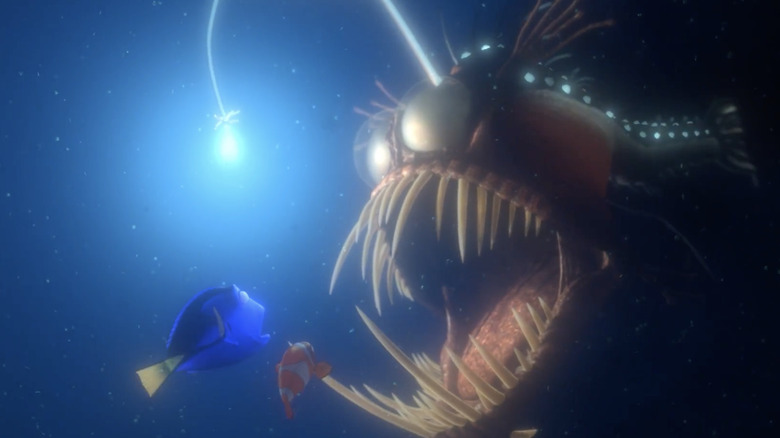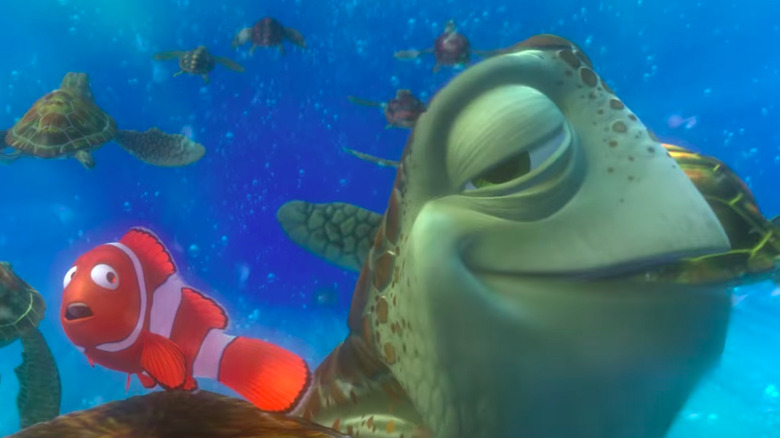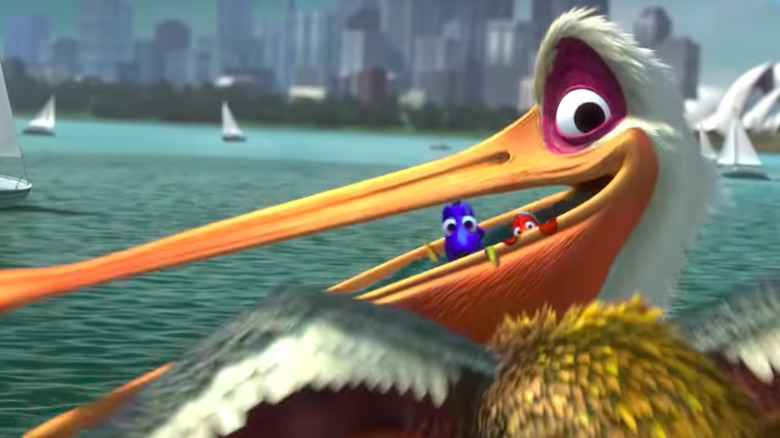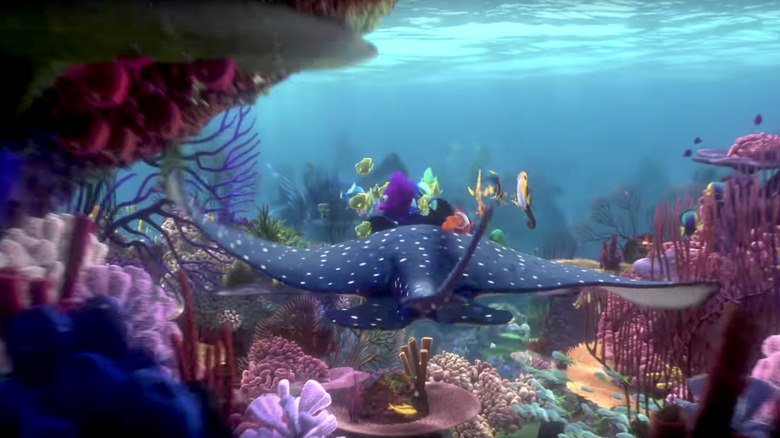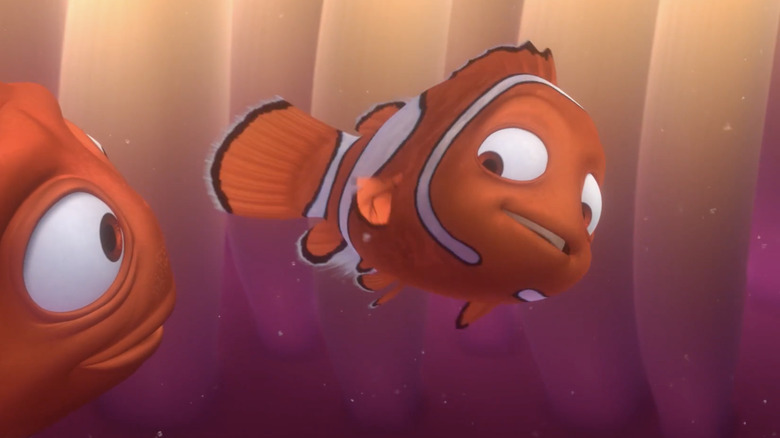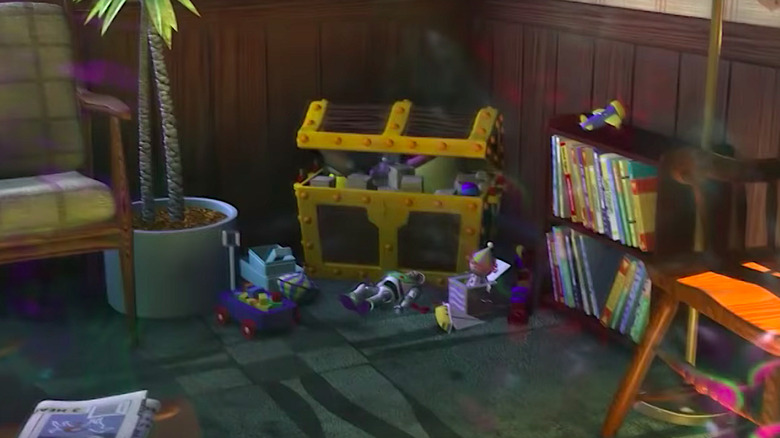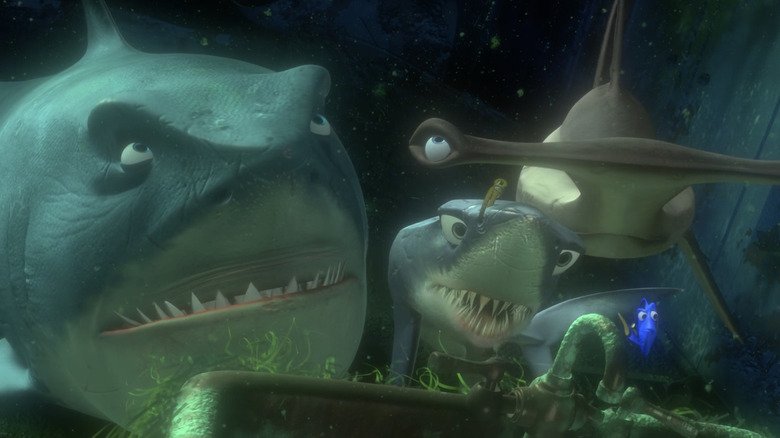Finding Nemo: Things Only Adults Notice In The Animated Classic
Finding Nemo premiered on May 30, 2003, and the movie was met with plenty of great reviews and great box office sales. It was a stellar film both for children and adults alike. The animated aspect of Finding Nemo certainly made it a children's movie, but the heart of the story appealed to older viewers as well, as it follows a dedicated father searching the ocean for his son who was taken by scuba divers.
Finding Nemo has heart, humor, and drama. All of those aspects play well together in the movie and work to make it the iconic film that it is. Still, when you watch Finding Nemo as an adult, there are definitely some things you take notice of that you might not have when you viewed it as a child — or whenever it was you first saw it! Seriously, there are plenty of things only adults notice in Finding Nemo, and that's part of what makes the movie so great.
Finding Nemo is so pretty
If you watched Finding Nemo as a child, you might have been mesmerized at the beauty of what was happening on the screen, but only an adult can really notice just how amazing the animation is. Finding Nemo's silly characters and underwater adventures definitely drew the attention of its younger viewers, but it was the beauty of it all that made adults want to stay and watch. In fact, according to Slate, the movie was packed with "astonishingly fluid animation" and "dazzling dimensional detail" that many Disney-Pixar films before it lacked.
Watching Finding Nemo as an adult is almost a magical experience because it's just so beautiful. As Slate reported, "You can sense that every frame contains hundreds of decisions about light and color and movement — and, more to the point, they're all inspired decisions!" Truly, the movie is absolutely stunning, and only adults can really appreciate all the effort that went into making it so magical.
Finding Nemo is truly heartbreaking
It's no secret that Disney movies have a bit of a reputation for being a little, well, dramatic. Even though they're geared towards children and are often animated, Disney movies aren't afraid to tug on the heartstrings, and they usually end up killing off a main character's parent (or parents, such as in Frozen) within the first ten minutes or so. This is no different with Finding Nemo. The charming children's movie portrays the tragic death of Nemo's mother, Coral, as well as his 399 other siblings all within the first scene of the film. It's definitely heartbreaking, and, while children obviously know Nemo's mom dies, they probably don't understand why.
Well, in an interview with Glamour, Disney producer Don Hahn explained why Disney movies have a tendency to be so sad at the beginning. "The movies are 80 or 90 minutes long, and Disney films are about growing up," he told the magazine. "They're about that day in your life when you have to accept responsibility. ... In shorthand, it's much quicker to have characters grow up when you bump off their parents." Obviously, it's sad, but it also makes sense, something only adults would be able to notice about Finding Nemo — and most other Disney movies for that matter.
The struggle of having an overprotective father is too real in Finding Nemo
As any parent knows, the thought of sending a child off to school for the first time can be seriously scary. In Finding Nemo, Nemo's father, Marlin, has obviously had a rough go of things after the death of his wife and most of his children. So it's only natural that he would be super protective of the only family member he has left: his son. Still, Finding Nemo takes the over-protective father role and totally ups the ante. Marlin is ultra-cautious of everything his son does, as is made clear in the scene of Nemo's first day of school, in which Marlin doubts whether or not Nemo should be going to school just yet.
There's a reason it's such a real scene and why a lot of adults can relate to Marlin's character. According to PixarTalk.com, Finding Nemo was "inspired by a fleeting moment of realization" from the movie's writer/director Andrew Stanton who "observed that his overprotective fatherly instincts were preventing him from properly bonding with his son." When children watch Finding Nemo, they probably just think Marlin is silly, but only adults will notice how realistic he is.
The foreshadowing in Finding Nemo is amazing
One of the coolest parts of Finding Nemo is how self-aware it is. For kids, the movie is silly, fun, and full of adventures. But when adults watch it, they might just pick up on the subtle foreshadowing in the movie. It's pretty smart of the writers to place little clues about what happens at the start of the movie because parents who watch it with their kids will be able to look back and realize that the hints were there all along.
For example, at the start of the movie, when Nemo heads off to school, some of his new classmates talk about sea turtles and sharks, which Marlin laughs off. Of course, later on in his search for his son, Marlin will encounter a dangerous shark and become friends with a sea turtle! Additionally, when Marlin meets Dory and she explains her short-term memory loss, she talks about her family and asks, "Where are they?" This line foreshadows the entire plot of the Finding Nemo sequel, Finding Dory.
The whole kid snatching thing in Finding Nemo is traumatizing
Again, Disney movies are known to be a little dramatic, what with all the deaths of parents and siblings and all. But Finding Nemo is especially so, and only as an adult can you really notice how traumatizing it is to watch a mother and almost all of her children get killed in one fell swoop.
In fact, a study completed by the University College London found that movies like Finding Nemo were a lot more violent than adult films like The Exorcism of Emily Rose, as reported by The Telegraph. "You don't get much more traumatic than a parent being eaten within the first few minutes of a film," Dr. James Kirkibride told The Telegraph. "I don't think it is any coincidence. I think that the producers use death as a plot device. Many characters in children's films are orphaned. But I think that it is important for adults to monitor what their children are watching and sit down with them and explain what is happening in case they are upset."
Adults definitely notice the trauma in Finding Nemo, but, hopefully, children don't.
Wait, is Finding Nemo commentary on human selfishness?
Obviously, the biggest plot point in Finding Nemo is when Nemo is taken by a group of scuba divers. It's super scary and shows the heartache any parent would feel if their child was taken away from them. But when adults watch Finding Nemo, that scene might hit closer to home. In fact, it might even be commentary on how humans think they own the world, specifically the ocean. In the scene where Nemo is taken, it's clear he's terrified and wants to go to his dad. But when the man who took him, the dentist, later tells a patient about how he found Nemo and says he saved the fish. Um, what?
That's definitely not what happened, and, when an adult watches Finding Nemo, they might wonder if the dentist's selfishness in taking Nemo was meant to be on purpose. After all, it's clear that Nemo wants to be in the ocean with his dad, and so do the other fish in the tank at the dentist's office. Maybe the writers didn't intend for the dentist to be an example of what not to do, but, for many adults, that's just what he is.
The cast of Finding Nemo is impressive
When children watch Finding Nemo, they might think a certain character is hilarious (like Dory) or adorable (like Squirt), but they probably won't realize that the voices behind some of those characters are seriously familiar. But for adults, as soon as they realize that Dory is played by Ellen DeGeneres, they can't help but notice that the cast of Finding Nemo has even more incredible names behind it.
For instance, Allison Janney is the voice behind Peach, the starfish in the dentist's fish tank, and Brad Garret plays Bloat, the puffer fish in the tank. Additionally, the voice of Crush, the helpful sea turtle that guides Marlin and Dory along the East Australian Current, belongs to none other than Andrew Stanton, the director of Finding Nemo, as noted by Bustle. According to Mental Floss, Stanton didn't actually plan on being the voice behind Crush, having only recorded the lines as a placeholder until they found an actor, but it just so happened to work out that way.
Finding Nemo showed that the deep ocean is terrifying
Part of the danger that Marlin is so concerned about in Finding Nemo is the open waters of the ocean, specifically the so-called "drop-off" where the reef in which they live drops off into the open ocean. It's definitely intimidating to see all that blue, and it's understandable why Marlin would be so concerned for the safety of his son. But really, it's what lies beneath the open ocean — the deep ocean — that's especially terrifying.
The scene in which Marlin and Dory have to fend off the angler fish in the deep ocean was scary and the fish is super creepy, no doubt leading adults to wonder what else is lurking down below. After all, the deep ocean is honestly still such a mystery when you think about it. While children may only see two little fish fighting a big fish, adults will notice just how terrifying that big fish is. Oh, and that angler fish totally exists in real life (via BuzzFeed). Yikes.
The parenting differences in Finding Nemo are hugely important
One of the biggest themes in Finding Nemo that children definitely don't pick up on is the difference in parenting styles. Obviously, Marlin is super overprotective, to the point of nearly driving his son mad. Marlin is a helicopter dad, but, even though his reasoning for being so is totally understandable (he lost almost everything in a matter of seconds), that doesn't mean he's right about everything.
On the opposite end of the parenting spectrum is Crush, the laidback sea turtle Marlin meets on his way to rescue Nemo. There's a clear difference in parenting styles between the two fathers, with Crush explaining to Marlin how baby sea turtles are left alone on the beach to find their way back home. In fact, in one scene, Crush's son Squirt falls out of the current and, while Marlin panics, Crush is chill about it. "Let us see what Squirt does flying solo," he says. The difference in parenting styles is something only adults would notice and relate to.
Finding Nemo proves that change can come from spreading information
As amazing as it is that Marlin crosses the ocean all to be with his son, he wouldn't have found him were it not for him sharing his story. While Marlin is with the sea turtles in the EAC, he tells them all that happened to Nemo: how his son went and touched the boat, how the divers took Nemo, and how he met Dory, fought off sharks, and swam through a field of jellyfish all so he could find his son. The story soon spread all the way across the ocean until it was heard by a pelican who just so happened to know Nemo and where he was.
It's amazing the power a story can have, and that scene in Finding Nemo definitely seems to play with the idea that change can happen all from sharing stories. Of course, that's really something only an adult would notice in Finding Nemo, but it's still pretty powerful. In today's world, viral stories are a dime a dozen, but they can still bring about change for the better.
Finding Nemo is super accurate in its depiction of the ocean
Again, Finding Nemo is beautifully made, but it's also super realistic and accurate in its depiction of the ocean. Considering the fact that it's an animated movie, Finding Nemo feels pretty real, especially when you watch it as an adult. Makes sense as the animators behind Finding Nemo took a lot of time to make sure that the film's visuals were on par with the real underwater world.
According to PixarTalk.com, the film's animators worked super hard to study the world of marine life. "Visits to aquariums, diving stints in Monterey and Hawaii, study sessions in front of Pixar's well-stocked 25-gallon fish tank, and a series of in-house lectures from an ichthyologist all helped to get them into the swim of things," PixarTalk.com noted. Clearly, all that time spent learning paid off because Finding Nemo almost makes adults feel like they're in an actual aquarium, or maybe even the ocean. It's that good.
Finding Nemo handles disability wonderfully
Children who've watched Finding Nemo are aware that Nemo has one fin that's smaller than the other. His dad calls it Nemo's "lucky fin," but only adults will notice that Nemo's "lucky fin" is a clear reference to a physical disability. Additionally, while children will laugh at Dory's short-term memory loss, adults will realize that her condition is also a nod to a mental condition. Finding Nemo shows characters with all kinds of conditions, and it does so in a way that totally normalizes them.
In fact, according to the Chicago Tribune, there are moments in Finding Nemo when "the characters who treat the identified 'challenged' characters differently often have a dawning awareness and deepening acceptance, as epiphanies free them from their own mental boxes." It's a powerful message for the creators of Finding Nemo to send, and definitely something only adults would pick up on in the film.
There are a lot of Easter eggs in Finding Nemo
As any Disney or Pixar fan knows, the makers of the animated films absolutely love to leave little references to other Disney and Pixar films throughout each movie. Most of the time, these Easter eggs are so small or pass by in the blink of an eye that kids don't realize they're there. But adults definitely notice the Easter eggs in Finding Nemo because there are quite a few of them.
For instance, in the waiting room of dentist Dr. Sherman's office, a child is sitting with his mother and reading a magazine. And who is on the cover of that magazine? Mr. Incredible from The Incredibles, of course! That's not all that's hiding in the movie though. There's also a toy Buzz Lightyear, a Pizza Planet truck (also from Toy Story), and Monsters Inc.'s Mike Wazowski in Finding Nemo (via PixarTalk.com).
There's some adult humor in Finding Nemo
Finally, even though Finding Nemo is hilarious for kids to watch — between Dory, Darla, and all the sea turtles — there are some moments in the film that seem to be just for the grown-ups. It's not uncommon for the writers of kids' movies to throw in some adult humor for the parents to appreciate, and that definitely seems to have been the case with Finding Nemo.
At one point, the fish in the tank in Dr. Sherman's office are scanned by a cleaning machine, and one of the fish covers his private area. In another scene, the format of the sharks' meeting to stop eating fish is clearly modeled after an Alcoholics Anonymous addiction meeting, something only adults would notice. Moreover, the shark Bruce in his hungry quest for fish says, "Here's Brucey!" which is a clear reference to the scene in The Shining when Jack Nicholson shouts, "Here's Johnny!"
Clearly, there are certain things only adults will notice in Finding Nemo.
